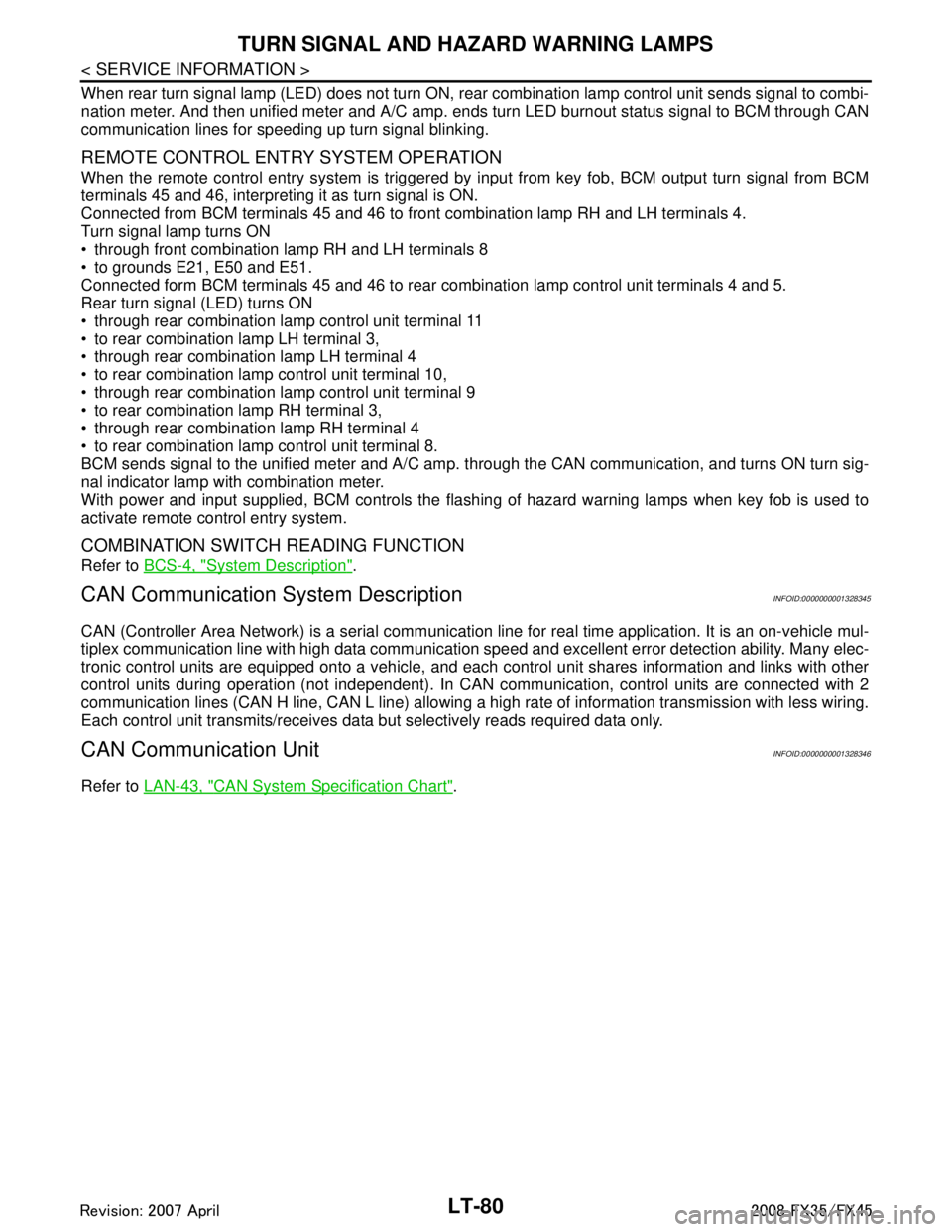2008 INFINITI FX35 remote control
[x] Cancel search: remote controlPage 840 of 3924

BL-106
< SERVICE INFORMATION >
INTELLIGENT KEY SYSTEM
Trouble Diagnosis Symptom Chart
INFOID:0000000001327851
ALL FUNCTIONS OF THE INTELLIGENT KEY ARE NOT OPERATING
Selective door unlock function using Intelli-
gent Key remote controller button operation ××× ×××
Door lock/unlock operation using mechani-
cal key ×
Ignition knob rotation permission using In-
telligent Key ××× × × × × ×
Ignition knob rotation permission using me-
chanical key ×× × × ×× ×
Engine start using Intelligent Key × × × ××× ×××
Engine start using mechanical key ×× ×× ×××
Key reminder door lock operation ××××××××
Selector lever reminder operation ×× ××× ×
Ignition switch return forgotten warning ××× × × × ×
Ignition key warning (when using mechani-
cal key) ××××
Ignition switch OFF position warning (for in-
side car: when door closed) ×××× × × ×
Ignition switch OFF position warning (for
outside car: when door opened/closed) ×××× × ×× × ××
Warning for removal of Intelligent Key to
outside the car (when door open/closed) ××× × × ×× × × ×
Warning for removal of Intelligent Key to
outside the car (from window) ××× × × × × ×
Door lock non-operation warning × ××× ××× × ×
Intelligent key low battery warning ×× ×××
Will not operate if there is a malfunction in
the area where there is a ×.
Intelligent Key
Key switch
Ignition knob switch ACC switch
Ignition switch
Door unlock sensor
Door switch
Door request switch
Inside key antenna
Out side key antenna
Intelligent Key warning buzzer Intelligent Key unit
CAN communication system
BCM
Combination meter
Steering lock unitSto p l am p s w it ch Detention switch
Passenger side select unlock relay
Symptom Diagnoses service procedure Refer to page
“KEY” and “P shift” warning lamps in combination
meter do not light up at all. 1.
Check Intelligent Key unit power supply and ground cir-
cuit B L - 111
2. Check CAN co
mmunication BCS-13
3. Replace Intelligent Key unit BL-130
3AA93ABC3ACD3AC03ACA3AC03AC63AC53A913A773A893A873A873A8E3A773A983AC73AC93AC03AC3
3A893A873A873A8F3A773A9D3AAF3A8A3A8C3A863A9D3AAF3A8B3A8C
Page 841 of 3924

INTELLIGENT KEY SYSTEMBL-107
< SERVICE INFORMATION >
C
DE
F
G H
J
K L
M A
B
BL
N
O P
REMOTE CONTROL ENTRY FUNCTION MALFUNCTION
DOOR LOCK FUNCTION MALFUNCTION
Before conducting the diagnosis in the following table, check all power door lock system function. Refer to BL-
21.
“KEY” and “P shift” warning lamps in combination
meter turn on, but doors cannot be locked/un-
locked or the engine can not be started using Intel-
ligent Key. 1.
Use CONSULT-III to check if the Intelligent Key has
been registered Refer to
CONSULT-III
Operation Manual
2. Use CONSULT-III setting change function to check if In-
telligent Key system has been cancelled BL-104
3. Intelligent Key battery inspection
BL-130
4. Replace Intelligent Key unitBL-130
Symptom Diagnoses service procedure Refer to page
Symptom Diagnoses service procedure Refer to page
Door lock/unlock does not operate (other func-
tions normal) when Intelligent Key remote control-
ler button is operated. 1. Check door lock/unlock setting
BL-104
2. Intelligent Key battery inspectionBL-130
3. Check door unlock sensor BL-117
4. Check door switchBL-115
5. Replace BCMBCS-13
6. Replace Intelligent Key unit BL-130
Driver side selective door unlock function does
not operate, when Intelligent Key remote control-
ler button is operated.
(All other remote control entry function is OK.) 1. Check selective door unlock setting
BL-104
2. Replace BCMBCS-13
3. Replace Intelligent Key unit BL-130
Panic alarm (horn and headlamp) do not activate,
when panic alarm button is continuously pressed.
(All other remote control entry function is OK.) 1. Check panic alarm mode
BL-104
2. Check headlamp functionBL-129
3. Check horn functionBL-129
4. Check IPDM E/R operationBL-129
5. Check key switch (Intelligent Key unit input) BL-112
6. Check ignition knob switchBL-114
7. Replace Intelligent Key unitBL-130
Hazard lamps do not flash during door lock oper-
ation using Intelligent Key remote controller but-
ton operated.
(Turn signal lamp operation is OK.)
(All other remote control entry function is OK.) 1. Check key reminder setting
BL-104
2. Replace BCMBCS-13
3. Replace Intelligent Key unit BL-130
Hazard lamps do not flash during door lock oper-
ation using Intelligent Key remote controller but-
ton operated.
(Turn signal lamps do not operate.)Check hazard function
BL-128
Intelligent Key warning buzzer does not sound
during door lock/unlock operation using Intelligent
Key remote controller button is operated.
(All other remote control entry function is OK.) 1.
Check if the operation confirmation Intelligent Key
warning buzzer was cancelled by the CONSULT-III set-
tings change function
BL-104
2. Check Intelligent Key warning buzzer
BL-120
3. Replace Intelligent Key unitBL-130
3AA93ABC3ACD3AC03ACA3AC03AC63AC53A913A773A893A873A873A8E3A773A983AC73AC93AC03AC3
3A893A873A873A8F3A773A9D3AAF3A8A3A8C3A863A9D3AAF3A8B3A8C
Page 842 of 3924

BL-108
< SERVICE INFORMATION >
INTELLIGENT KEY SYSTEM
ENGINE START FUNCTION MALFUNCTION
Intelligent Key Operation Inspection
Symptom Diagnoses service procedure Refer to page
Door lock/unlock does not operate when door
request switch operation is used (power door
lock system is normal). 1. Check door lock/unlock setting
BL-104
2. Check outside key antennaBL-121
3. Intelligent Key battery inspectionBL-130
4. Replace Intelligent Key unitBL-130
Door lock/unlock do not operate using door re-
quest switch operated (power door lock system
is normal).1. Check door switch
BL-1152. Check key switch (Intelligent Key unit input)BL-112
3. Check ignition knob switchBL-114
4. Replace Intelligent Key unitBL-130
Driver side selective door unlock function does
not operate, when door request switch is operat-
ed.
(All other door lock function is OK.)1. Check selective door unlock setting
BL-104
2. Replace BCMBCS-13
Passenger side selective door unlock function
does not operate, when door request switch is
operated.
(All other door lock function is OK.)1. Check selective door unlock setting
BL-104
2. Check passenger side select unlock relayBL-128
3. Replace Intelligent Key unitBL-130
Hazard lamps do not flash during door lock op-
eration using door request switch operated.
(Turn signal lamp operation is normal.)
(All other door lock function is OK.)1. Check key reminder setting
BL-104
2. Replace BCMBCS-13
3. Replace Intelligent Key unit BL-130
Hazard lamps do not flash during door lock op-
eration using door request switch operated.
(Turn signal lamps do not operate.)Check hazard function
BL-128
Intelligent Key warning buzzer does not sound
during door lock/unlock operation using Intelli-
gent Key (regardless of whether Intelligent Key
remote controller button or request switch oper-
ation is used). 1. Check if the operation confirmation Intelligent Key
warning buzzer was cancelled by the CONSULT-III
settings change function BL-104
2. Check Intelligent Key warning buzzer
BL-120
3. Replace Intelligent Key unitBL-130
Door lock/unlock operation confirmation Intelli-
gent Key warning buzzer sounds, but door lock
actuator does not operate. (And hazard lamps
do not flash.)1. Check CAN communication
BCS-13
2. Replace Intelligent Key unit BL-130
3AA93ABC3ACD3AC03ACA3AC03AC63AC53A913A773A893A873A873A8E3A773A983AC73AC93AC03AC3
3A893A873A873A8F3A773A9D3AAF3A8A3A8C3A863A9D3AAF3A8B3A8C
Page 900 of 3924

BL-166
< SERVICE INFORMATION >
VEHICLE SECURITY (THEFT WARNING) SYSTEM
When headlamp high relay (with built-in IPDM E/R) and horn relay are energized and then power is supplied
to headlamps (LH and RH) and horns (HIGH and LOW).
The headlamps flash and the horn sounds intermittently.
The alarm automatically turns off after 50 seconds, but will reactivate if the vehicle is tampered with again.
VEHICLE SECURITY SYSTEM DEACTIVATION
To deactivate the vehicle security system, a door or the back door must be unlocked with the key, key fob or
Intelligent Key.
When the key is used to unlock a door, BCM terminal 22 receives signal
from terminal 14 of the power window ma in switch (door lock and unlock switch).
When the BCM receives either one of these signals or unl ock signal from key cylinder switch, key fob or Intel-
ligent Key, the vehicle security sy stem is deactivated. (Disarmed phase)
PANIC ALARM OPERATION
Remote keyless entry system may or may not operat e vehicle security system (horn and headlamps) as
required.
When the remote keyless entry system is triggered, ground is supplied intermittently from IPDM E/R terminals
38 and 60.
When headlamp relay (which built-in IPDM E/R) and hor n relay are energized and then power is supplied to
headlamps (LH and RH) and horns (HIGH and LOW).
The headlamp flashes and the hor n sounds intermittently.
The alarm automatically turns off after 25 seconds or when BCM receives any signal from key fob or Intelligent
Key.
CAN Communication System DescriptionINFOID:0000000001327906
CAN (Controller Area Network) is a serial communication line for real time application. It is an on-vehicle mul-
tiplex communication line with high data communication s peed and excellent error detection ability. Many elec-
tronic control units are equipped onto a vehicle, and each control unit shares information and links with other
control units during operation (not independent). In CA N communication, control units are connected with 2
communication lines (CAN H line, CAN L line) allowing a high rate of information transmission with less wiring.
Each control unit transmits/receives data but selectively reads required data only.
CAN Communication UnitINFOID:0000000001327907
Refer to LAN-43, "CAN System Specification Chart".
3AA93ABC3ACD3AC03ACA3AC03AC63AC53A913A773A893A873A873A8E3A773A983AC73AC93AC03AC3
3A893A873A873A8F3A773A9D3AAF3A8A3A8C3A863A9D3AAF3A8B3A8C
Page 910 of 3924

BL-176
< SERVICE INFORMATION >
VEHICLE SECURITY (THEFT WARNING) SYSTEM
Trouble Diagnosis
INFOID:0000000001327913
WORK FLOW
“POWER DOOR LOCK SYSTEM” Diagnosis; refer to BL-36, "Work Flow".
“REMOTE CONTROL SYSTEM” Diagnosis; refer to BL-62, "
Work Flow".
“INTELLIGENT KEY SYSTE M” Diagnosis; refer to BL-103, "
Diagnosis Procedure".
PIIA6909E
3AA93ABC3ACD3AC03ACA3AC03AC63AC53A913A773A893A873A873A8E3A773A983AC73AC93AC03AC3
3A893A873A873A8F3A773A9D3AAF3A8A3A8C3A863A9D3AAF3A8B3A8C
Page 3182 of 3924

LT-80
< SERVICE INFORMATION >
TURN SIGNAL AND HAZARD WARNING LAMPS
When rear turn signal lamp (LED) does not turn ON, rear combination lamp control unit sends s\
ignal to combi-
nation meter. And then unified meter and A/C amp. ends turn LED burnout status signal to BCM through CAN
communication lines for speeding up turn signal blinking.
REMOTE CONTROL ENTRY SYSTEM OPERATION
When the remote control entry system is triggered by i nput from key fob, BCM output turn signal from BCM
terminals 45 and 46, interpreting it as turn signal is ON.
Connected from BCM terminals 45 and 46 to front combination lamp RH and LH terminals 4.
Turn signal lamp turns ON
through front combination lamp RH and LH terminals 8
to grounds E21, E50 and E51.
Connected form BCM terminals 45 and 46 to rear combination lamp control unit terminals 4 and 5.
Rear turn signal (LED) turns ON
through rear combination lamp control unit terminal 11
to rear combination lamp LH terminal 3,
through rear combination lamp LH terminal 4
to rear combination lamp control unit terminal 10,
through rear combination lamp control unit terminal 9
to rear combination lamp RH terminal 3,
through rear combination lamp RH terminal 4
to rear combination lamp control unit terminal 8.
BCM sends signal to the unified meter and A/C amp. through the CAN communication, and turns ON turn sig-
nal indicator lamp with combination meter.
With power and input supplied, BCM controls the flashing of hazard warning lamps when key fob is used to
activate remote control entry system.
COMBINATION SWITCH READING FUNCTION
Refer to BCS-4, "System Description".
CAN Communication System DescriptionINFOID:0000000001328345
CAN (Controller Area Network) is a serial communication line for real time application. It is an on-vehicle mul-
tiplex communication line with high data communication s peed and excellent error detection ability. Many elec-
tronic control units are equipped onto a vehicle, and each control unit shares information and links with other
control units during operation (not independent). In CA N communication, control units are connected with 2
communication lines (CAN H line, CAN L line) allowing a high rate of information transmission with less wiring.
Each control unit transmits/receives data but selectively reads required data only.
CAN Communication UnitINFOID:0000000001328346
Refer to LAN-43, "CAN System Specification Chart".
3AA93ABC3ACD3AC03ACA3AC03AC63AC53A913A773A893A873A873A8E3A773A983AC73AC93AC03AC3
3A893A873A873A8F3A773A9D3AAF3A8A3A8C3A863A9D3AAF3A8B3A8C
Page 3271 of 3924

ILLUMINATIONLT-169
< SERVICE INFORMATION >
C
DE
F
G H
I
J
L
M A
B
LT
N
O P
ILLUMINATION
System DescriptionINFOID:0000000001328422
Control of illumination lamps operation is dependent upon position of lighting switch (combination switch).
When lighting switch is placed in the 1ST or 2ND positi on (or if auto light system is activated), BCM (body con-
trol module) receives input signal requesting illuminati on lamps to illuminate. This input signal is communi-
cated to IPDM E/R (intelligent power distribution module engine room) through the CAN communication. The
CPU (central processing unit) located in the IPDM E/R co ntrols tail lamp relay coil. This relay, when energized,
directs power to illumination lamps, which then illuminate.
Power is supplied at all times
through 10A fuse (No. 71, located in IPDM E/R)
to tail lamp relay, located in IPDM E/R, and
to CPU located in IPDM E/R.
Power is also supplied at all times
through 50A fusible link (letter M, located in fuse, fusible link and relay box)
to BCM terminal 55,
through 15A fuse [No. 22 located in fuse block (J/B)]
to BCM terminal 42,
through 15A fuse (No. 78, located in IPDM E/R)
to CPU located in IPDM E/R,
through 10A fuse [No. 19 located in fuse block (J/B)]
to unified meter and A/C amp. terminal 21 and
to combination meter terminal 8.
With ignition switch in ON or START position, power is supplied
to ignition relay, located in IPDM E/R, from battery direct,
through 15A fuse [No. 1 located in fuse block (J/B)]
to BCM terminal 38,
through 10A fuse [No. 12, located in fuse block (J/B)]
to unified meter and A/C amp. terminal 22 and
to combination meter terminal 7.
With ignition switch in ACC or ON position, power is supplied
through 10A fuse [No. 6, located in fuse block (J/B)]
to combination meter terminal 4 and
to BCM terminal 11.
Ground is supplied
to BCM terminals 49 and 52
to unified meter and A/C amp. terminals 29 and 30, and
to combination meter terminals 5, 6, and 15
through grounds M35, M45, and M85,
to IPDM E/R terminals 38 and 60
through grounds E21, E50, and E51.
ILLUMINATION OPERATION BY LIGHTING SWITCH
With lighting switch in the 1ST or 2ND position (or if auto light system is activated), BCM receives input signal
requesting illumination lamps to illuminate. This input signal is communicated to IPDM E/R through the CAN
communication. The CPU located in the IPDM E/R controls tail lamp relay coil, which, when energized, directs
power
through IPDM E/R terminal 22
to glove box lamp terminal 1
to A/T device (illumination) terminal 11
to snow mode switch (illumination) terminal 5
to VDC off switch (illumination) terminal 3
to clock (illumination) terminal 3
to hazard switch (illumination) terminal 3
to heated seat switch (driver side) (illumination) terminal 5
to heated seat switch (passenger side) (illumination) terminal 5
to door mirror remote control switch (illumination) terminal 16
to LDW switch (illumination) terminal 5
to combination switch (spiral cable) terminal 26
to microphone terminal 2 (with telephone system)
3AA93ABC3ACD3AC03ACA3AC03AC63AC53A913A773A893A873A873A8E3A773A983AC73AC93AC03AC3
3A893A873A873A8F3A773A9D3AAF3A8A3A8C3A863A9D3AAF3A8B3A8C
Page 3272 of 3924

LT-170
< SERVICE INFORMATION >
ILLUMINATION
to A/C and AV switch (illumination) terminal 3
to DVD player (illumination) terminal 12
to coin box illumination terminal 2 and
to rear power window switch LH and RH (illumination) terminals 6,
through combination switch (spiral cable) terminal 18
to audio steering switch (illumination)
to icc steering switch (illumination) (with icc) and
to ascd steering switch (illumination) (without icc)
Illumination control
through combination meter terminal 19
to A/T device (illumination) terminal 12
to snow mode switch (illumination) terminal 6
to VDC off switch (illumination) terminal 4
to clock (illumination) terminal 4
to hazard switch (illumination) terminal 4
to heated seat switch (driver side) (illumination) terminal 6
to heated seat switch (passenger side) (illumination) terminal 6
to door mirror remote control switch terminal 15
to LDW switch (illumination) terminal 4,
to combination switch (spiral cable) terminal 27
to A/C and AV switch (illumination) terminal 4 and
to DVD player (illumination) terminal 10,
through combination switch (spiral cable) terminal 21
to audio steering switch (illumination)
to icc steering switch (illumination) (with icc) and
to ascd steering switch (illumination) (without icc)
Ground is supplied at all times
to glove box lamp terminal 2 and
to coin box illumination terminal 3
through grounds M35, M45 and M85,
to rear power window switch LH and RH (illumination) terminals 7
through grounds B15 and B45.
With power and ground supplied, illumination lamps illuminate.
EXTERIOR LAMP BATTERY SAVER CONTROL
When the lighting switch is in the 1ST or 2ND position (or if auto light system is activated), and ignition switch
is turned from ON or ACC to OFF, batte ry saver control function is activated.
Under this condition, illumination lamps remain illuminated for 5 minutes, then illumination lamps are turned
off.
When the lighting switch is turned from OFF to 1ST or 2 ND position (or if auto light system is activated) after
illumination lamps are turned off by battery save r control, and illumination lamps illuminate again.
Exterior lamp battery saver control mode can be changed by the function setting of CONSULT-III.
CAN Communication System DescriptionINFOID:0000000001328423
CAN (Controller Area Network) is a serial communication line for real time application. It is an on-vehicle mul-
tiplex communication line with high data communication s peed and excellent error detection ability. Many elec-
tronic control units are equipped onto a vehicle, and each control unit shares information and links with other
control units during operation (not independent). In CA N communication, control units are connected with 2
communication lines (CAN H line, CAN L line) allowing a high rate of information transmission with less wiring.
Each control unit transmits/receives data but selectively reads required data only.
CAN Communication UnitINFOID:0000000001328424
Refer to LAN-43, "CAN System Specification Chart".
3AA93ABC3ACD3AC03ACA3AC03AC63AC53A913A773A893A873A873A8E3A773A983AC73AC93AC03AC3
3A893A873A873A8F3A773A9D3AAF3A8A3A8C3A863A9D3AAF3A8B3A8C